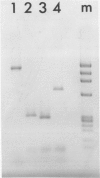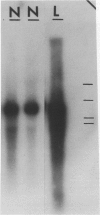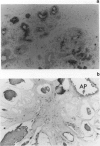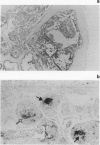Abstract
A cDNA library constructed from mRNA from a human breast carcinoma metastasis was screened with a polyclonal antibody to deglycosylated human milk fat globule membrane, resulting in the isolation of eight clones from a total of 10(5) plaques. One of these (J16) was identified as lactoferrin. It was highly expressed (as a 2.5 Kb mRNA) in lactating breast and in both normal resting tissue taken from adjacent to carcinoma or from reduction mammoplasties. Immunoreactive lactoferrin was localised to ductal cells and their secretions in both normal and mildly hyperplastic ducts. In a normal tissue screen J16 was highly expressed in stomach, poorly in skin and lymphocytes and absent from other organs examined. It was variably expressed in 33/59 invasive primary breast tumours; lactoferrin protein in these was heterogeneously distributed in epithelial tumour foci. Presence of J16 was inversely related to expression of oestrogen receptor protein (P = 0.0001). There was no significant relationship to other clinical parameters. We also found immunoreactivity in 20/41 (49%) cases of ductal carcinoma in situ. Expression was not observed in any breast or gastric cell line examined. Thus lactoferrin appears to be down regulated in some forms of cancer. The presence of lactoferrin could be a contraindication for effective endocrine therapy.
Full text
PDF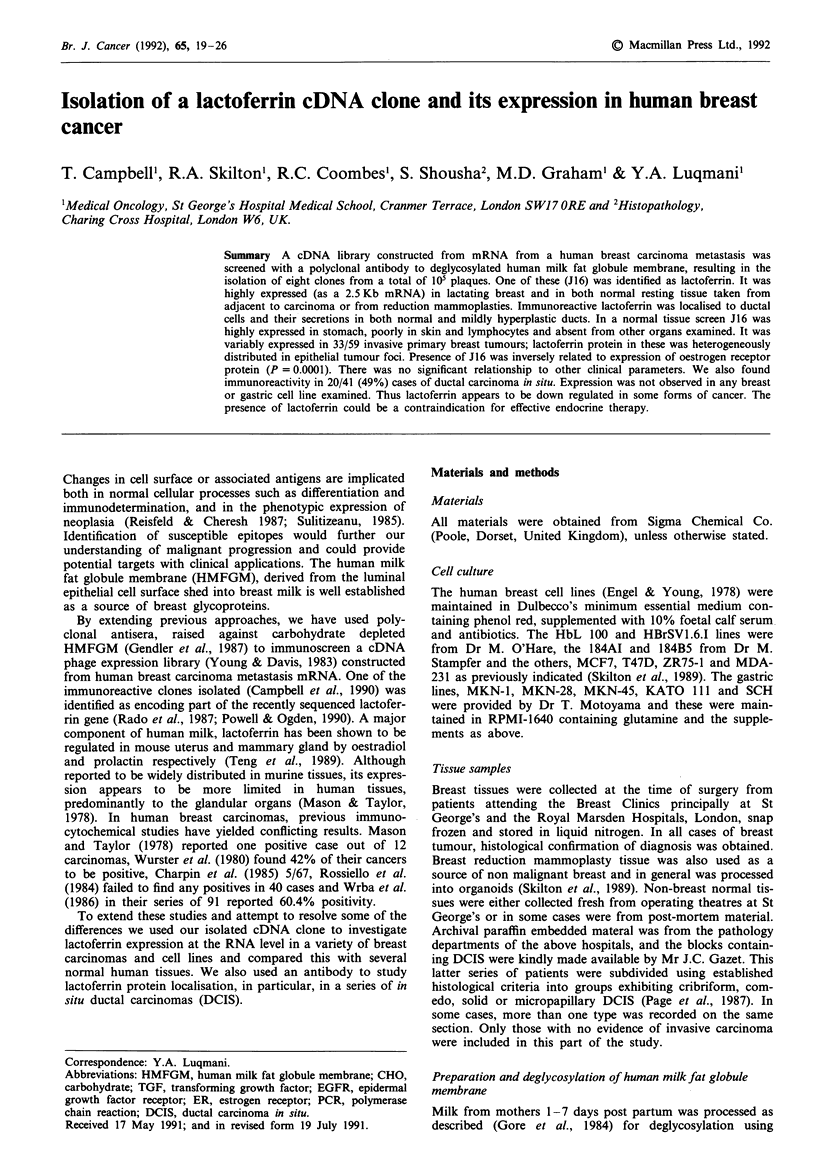
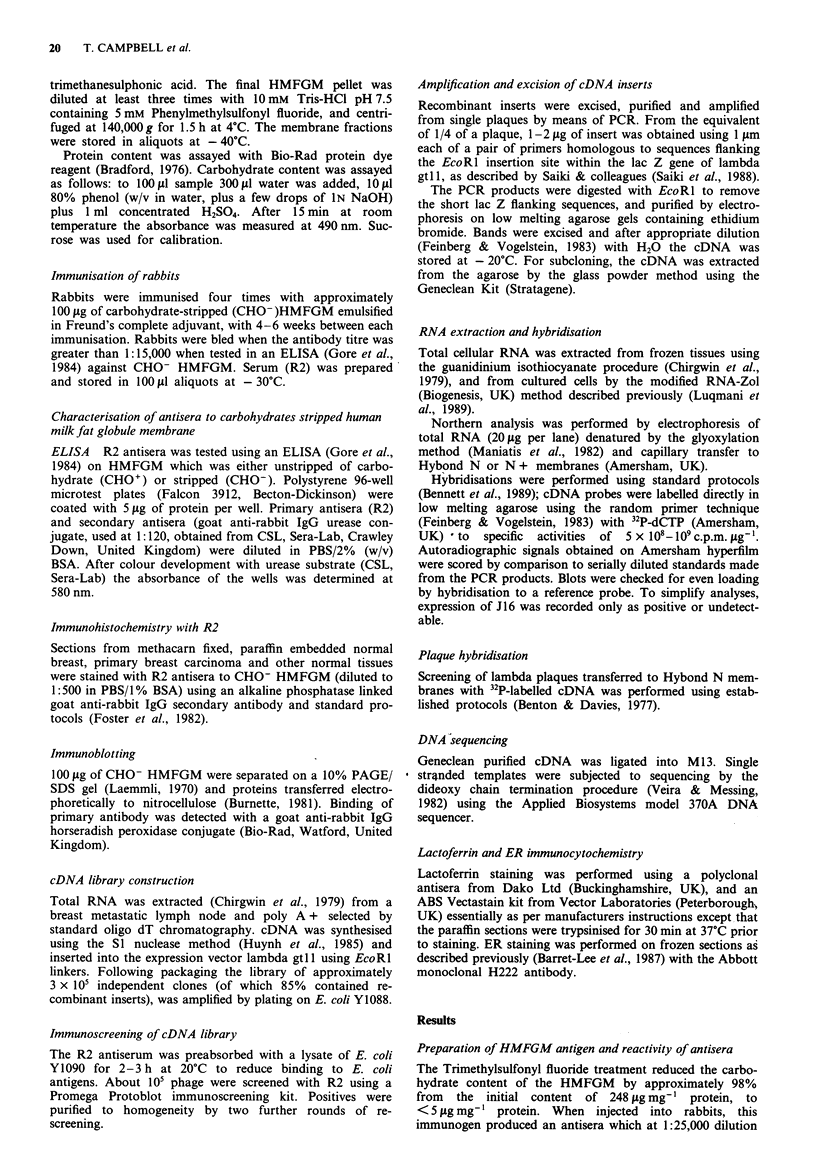
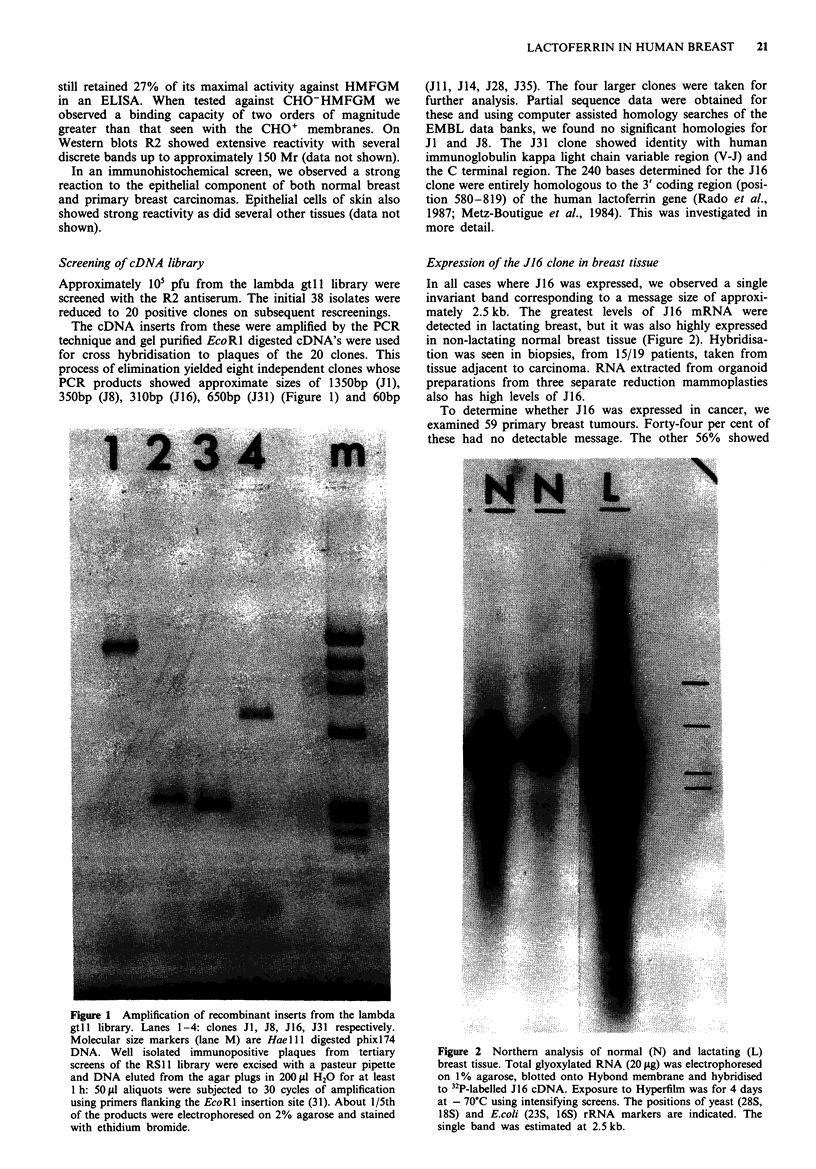
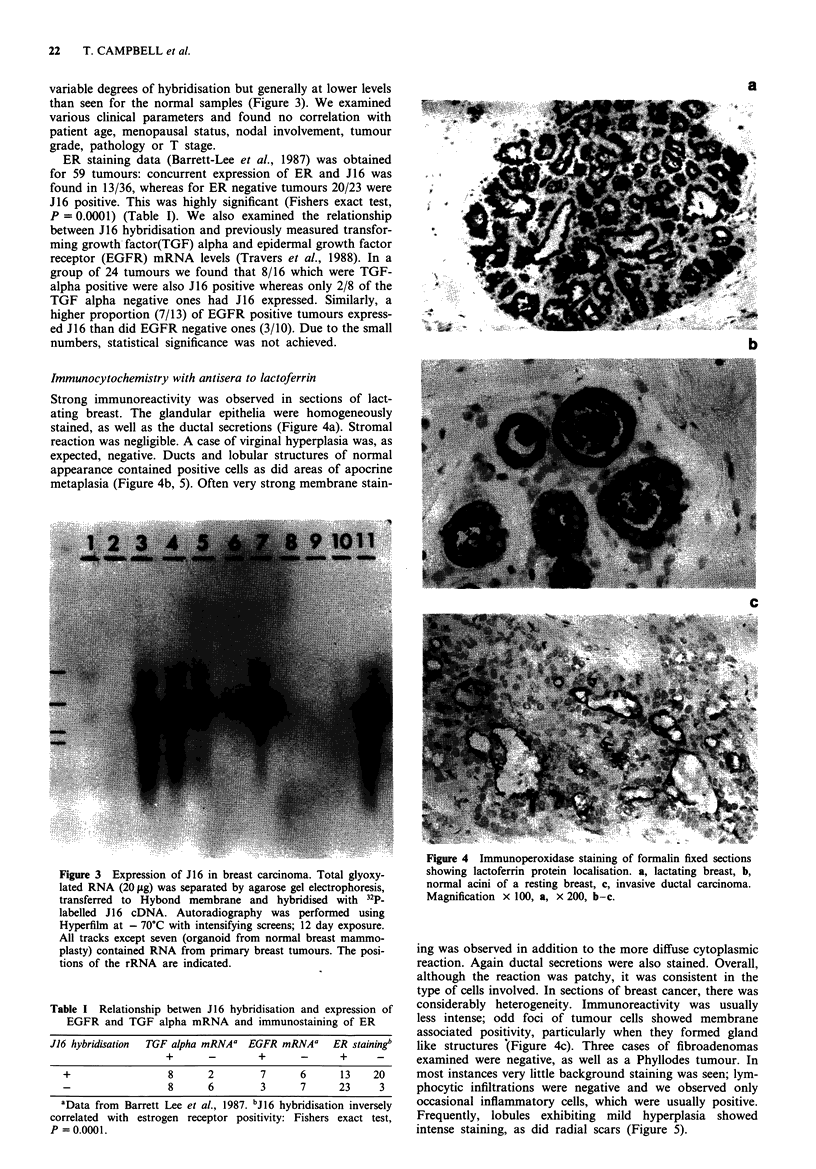


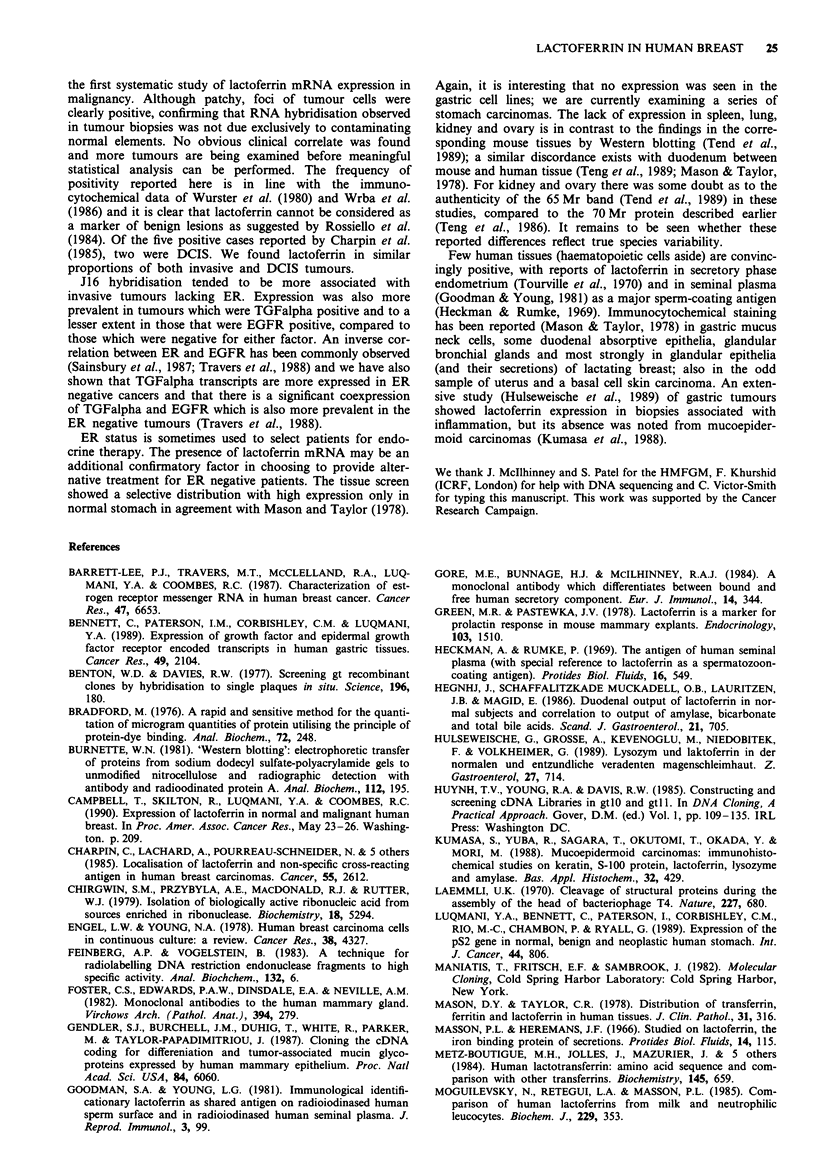
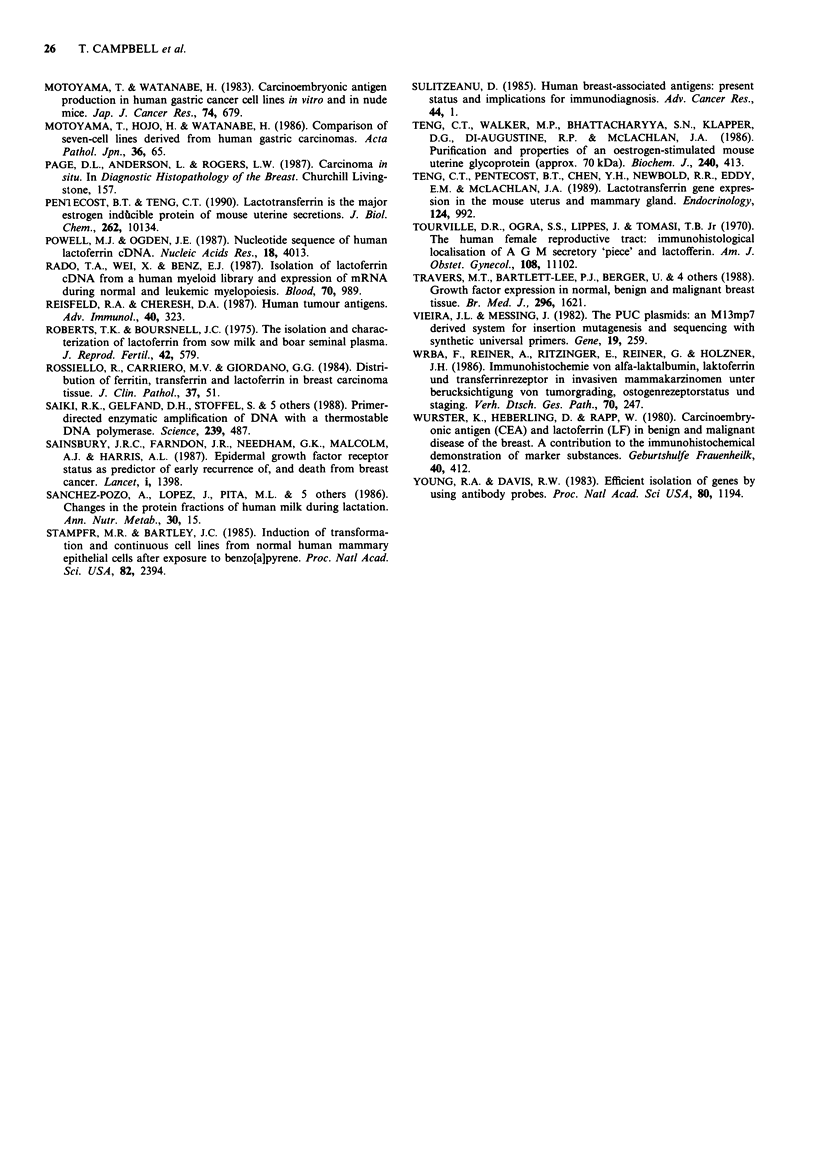
Images in this article
Selected References
These references are in PubMed. This may not be the complete list of references from this article.
- Barrett-Lee P. J., Travers M. T., McClelland R. A., Luqmani Y., Coombes R. C. Characterization of estrogen receptor messenger RNA in human breast cancer. Cancer Res. 1987 Dec 15;47(24 Pt 1):6653–6659. [PubMed] [Google Scholar]
- Bennett C., Paterson I. M., Corbishley C. M., Luqmani Y. A. Expression of growth factor and epidermal growth factor receptor encoded transcripts in human gastric tissues. Cancer Res. 1989 Apr 15;49(8):2104–2111. [PubMed] [Google Scholar]
- Benton W. D., Davis R. W. Screening lambdagt recombinant clones by hybridization to single plaques in situ. Science. 1977 Apr 8;196(4286):180–182. doi: 10.1126/science.322279. [DOI] [PubMed] [Google Scholar]
- Bradford M. M. A rapid and sensitive method for the quantitation of microgram quantities of protein utilizing the principle of protein-dye binding. Anal Biochem. 1976 May 7;72:248–254. doi: 10.1006/abio.1976.9999. [DOI] [PubMed] [Google Scholar]
- Burnette W. N. "Western blotting": electrophoretic transfer of proteins from sodium dodecyl sulfate--polyacrylamide gels to unmodified nitrocellulose and radiographic detection with antibody and radioiodinated protein A. Anal Biochem. 1981 Apr;112(2):195–203. doi: 10.1016/0003-2697(81)90281-5. [DOI] [PubMed] [Google Scholar]
- Charpin C., Lachard A., Pourreau-Schneider N., Jacquemier J., Lavaut M. N., Andonian C., Martin P. M., Toga M. Localization of lactoferrin and nonspecific cross-reacting antigen in human breast carcinomas. An immunohistochemical study using the avidin-biotin-peroxidase complex method. Cancer. 1985 Jun 1;55(11):2612–2617. doi: 10.1002/1097-0142(19850601)55:11<2612::aid-cncr2820551113>3.0.co;2-c. [DOI] [PubMed] [Google Scholar]
- Chirgwin J. M., Przybyla A. E., MacDonald R. J., Rutter W. J. Isolation of biologically active ribonucleic acid from sources enriched in ribonuclease. Biochemistry. 1979 Nov 27;18(24):5294–5299. doi: 10.1021/bi00591a005. [DOI] [PubMed] [Google Scholar]
- Engel L. W., Young N. A. Human breast carcinoma cells in continuous culture: a review. Cancer Res. 1978 Nov;38(11 Pt 2):4327–4339. [PubMed] [Google Scholar]
- Feinberg A. P., Vogelstein B. A technique for radiolabeling DNA restriction endonuclease fragments to high specific activity. Anal Biochem. 1983 Jul 1;132(1):6–13. doi: 10.1016/0003-2697(83)90418-9. [DOI] [PubMed] [Google Scholar]
- Foster C. S., Edwards P. A., Dinsdale E. A., Neville A. M. Monoclonal antibodies to the human mammary gland. I. Distribution of determinants in non-neoplastic mammary and extra mammary tissues. Virchows Arch A Pathol Anat Histol. 1982;394(3):279–293. doi: 10.1007/BF00430671. [DOI] [PubMed] [Google Scholar]
- Gendler S. J., Burchell J. M., Duhig T., Lamport D., White R., Parker M., Taylor-Papadimitriou J. Cloning of partial cDNA encoding differentiation and tumor-associated mucin glycoproteins expressed by human mammary epithelium. Proc Natl Acad Sci U S A. 1987 Sep;84(17):6060–6064. doi: 10.1073/pnas.84.17.6060. [DOI] [PMC free article] [PubMed] [Google Scholar]
- Goodman S. A., Young L. G. Immunological identification of lactoferrin as a shared antigen on radioiodinated human sperm surface and in radioiodinated human seminal plasma. J Reprod Immunol. 1981 Jun;3(2):99–108. doi: 10.1016/0165-0378(81)90014-0. [DOI] [PubMed] [Google Scholar]
- Gore M. E., Bunnage H. J., McIlhinney R. A. A monoclonal antibody which differentiates between bound and free human secretory component. Eur J Immunol. 1984 Apr;14(4):344–349. doi: 10.1002/eji.1830140413. [DOI] [PubMed] [Google Scholar]
- Grosse Hülsewiesche A., Grosse G., Kevenoglu M., Niedobitek F., Volkheimer G. Lysozym und Laktoferrin in der normalen und entzündlich veränderten Magenschleimhaut. Z Gastroenterol. 1989 Dec;27(12):714–721. [PubMed] [Google Scholar]
- Hegnhøj J., Schaffalitzky de Muckadell O. B., Lauritzen J. B., Magid E. Duodenal output of lactoferrin in normal subjects and correlation to output of amylase, bicarbonate, and total bile acids. Scand J Gastroenterol. 1986 Aug;21(6):705–710. doi: 10.3109/00365528609011104. [DOI] [PubMed] [Google Scholar]
- Kumasa S., Yuba R., Sagara S., Okutomi T., Okada Y., Mori M. Mucoepidermoid carcinomas: immunohistochemical studies on keratin, S-100 protein, lactoferrin, lysozyme and amylase. Basic Appl Histochem. 1988;32(4):429–441. [PubMed] [Google Scholar]
- Laemmli U. K. Cleavage of structural proteins during the assembly of the head of bacteriophage T4. Nature. 1970 Aug 15;227(5259):680–685. doi: 10.1038/227680a0. [DOI] [PubMed] [Google Scholar]
- Luqmani Y., Bennett C., Paterson I., Corbishley C. M., Rio M. C., Chambon P., Ryall G. Expression of the pS2 gene in normal, benign and neoplastic human stomach. Int J Cancer. 1989 Nov 15;44(5):806–812. doi: 10.1002/ijc.2910440510. [DOI] [PubMed] [Google Scholar]
- Mason D. Y., Taylor C. R. Distribution of transferrin, ferritin, and lactoferrin in human tissues. J Clin Pathol. 1978 Apr;31(4):316–327. doi: 10.1136/jcp.31.4.316. [DOI] [PMC free article] [PubMed] [Google Scholar]
- Metz-Boutigue M. H., Jollès J., Mazurier J., Schoentgen F., Legrand D., Spik G., Montreuil J., Jollès P. Human lactotransferrin: amino acid sequence and structural comparisons with other transferrins. Eur J Biochem. 1984 Dec 17;145(3):659–676. doi: 10.1111/j.1432-1033.1984.tb08607.x. [DOI] [PubMed] [Google Scholar]
- Moguilevsky N., Retegui L. A., Masson P. L. Comparison of human lactoferrins from milk and neutrophilic leucocytes. Relative molecular mass, isoelectric point, iron-binding properties and uptake by the liver. Biochem J. 1985 Jul 15;229(2):353–359. doi: 10.1042/bj2290353. [DOI] [PMC free article] [PubMed] [Google Scholar]
- Motoyama T., Hojo H., Watanabe H. Comparison of seven cell lines derived from human gastric carcinomas. Acta Pathol Jpn. 1986 Jan;36(1):65–83. doi: 10.1111/j.1440-1827.1986.tb01461.x. [DOI] [PubMed] [Google Scholar]
- Motoyama T., Watanabe H. Carcinoembryonic antigen production in human gastric cancer cell lines in vitro and in nude mice. Gan. 1983 Oct;74(5):679–686. [PubMed] [Google Scholar]
- Pentecost B. T., Teng C. T. Lactotransferrin is the major estrogen inducible protein of mouse uterine secretions. J Biol Chem. 1987 Jul 25;262(21):10134–10139. [PubMed] [Google Scholar]
- Powell M. J., Ogden J. E. Nucleotide sequence of human lactoferrin cDNA. Nucleic Acids Res. 1990 Jul 11;18(13):4013–4013. doi: 10.1093/nar/18.13.4013. [DOI] [PMC free article] [PubMed] [Google Scholar]
- Rado T. A., Wei X. P., Benz E. J., Jr Isolation of lactoferrin cDNA from a human myeloid library and expression of mRNA during normal and leukemic myelopoiesis. Blood. 1987 Oct;70(4):989–993. [PubMed] [Google Scholar]
- Reisfeld R. A., Cheresh D. A. Human tumor antigens. Adv Immunol. 1987;40:323–377. doi: 10.1016/s0065-2776(08)60242-4. [DOI] [PubMed] [Google Scholar]
- Roberts T. K., Boursnell J. C. The isolation and characterization of lactoferrin from sow milk and boar seminal plasma. J Reprod Fertil. 1975 Mar;42(3):579–582. doi: 10.1530/jrf.0.0420579. [DOI] [PubMed] [Google Scholar]
- Rossiello R., Carriero M. V., Giordano G. G. Distribution of ferritin, transferrin and lactoferrin in breast carcinoma tissue. J Clin Pathol. 1984 Jan;37(1):51–55. doi: 10.1136/jcp.37.1.51. [DOI] [PMC free article] [PubMed] [Google Scholar]
- Saiki R. K., Gelfand D. H., Stoffel S., Scharf S. J., Higuchi R., Horn G. T., Mullis K. B., Erlich H. A. Primer-directed enzymatic amplification of DNA with a thermostable DNA polymerase. Science. 1988 Jan 29;239(4839):487–491. doi: 10.1126/science.2448875. [DOI] [PubMed] [Google Scholar]
- Sainsbury J. R., Farndon J. R., Needham G. K., Malcolm A. J., Harris A. L. Epidermal-growth-factor receptor status as predictor of early recurrence of and death from breast cancer. Lancet. 1987 Jun 20;1(8547):1398–1402. doi: 10.1016/s0140-6736(87)90593-9. [DOI] [PubMed] [Google Scholar]
- Stampfer M. R., Bartley J. C. Induction of transformation and continuous cell lines from normal human mammary epithelial cells after exposure to benzo[a]pyrene. Proc Natl Acad Sci U S A. 1985 Apr;82(8):2394–2398. doi: 10.1073/pnas.82.8.2394. [DOI] [PMC free article] [PubMed] [Google Scholar]
- Sulitzeanu D. Human cancer-associated antigens: present status and implications for immunodiagnosis. Adv Cancer Res. 1985;44:1–42. doi: 10.1016/s0065-230x(08)60024-x. [DOI] [PubMed] [Google Scholar]
- Teng C. T., Pentecost B. T., Chen Y. H., Newbold R. R., Eddy E. M., McLachlan J. A. Lactotransferrin gene expression in the mouse uterus and mammary gland. Endocrinology. 1989 Feb;124(2):992–999. doi: 10.1210/endo-124-2-992. [DOI] [PubMed] [Google Scholar]
- Teng C. T., Walker M. P., Bhattacharyya S. N., Klapper D. G., DiAugustine R. P., McLachlan J. A. Purification and properties of an oestrogen-stimulated mouse uterine glycoprotein (approx. 70 kDa). Biochem J. 1986 Dec 1;240(2):413–422. doi: 10.1042/bj2400413. [DOI] [PMC free article] [PubMed] [Google Scholar]
- Travers M. T., Barrett-Lee P. J., Berger U., Luqmani Y. A., Gazet J. C., Powles T. J., Coombes R. C. Growth factor expression in normal, benign, and malignant breast tissue. Br Med J (Clin Res Ed) 1988 Jun 11;296(6637):1621–1624. doi: 10.1136/bmj.296.6637.1621. [DOI] [PMC free article] [PubMed] [Google Scholar]
- Vieira J., Messing J. The pUC plasmids, an M13mp7-derived system for insertion mutagenesis and sequencing with synthetic universal primers. Gene. 1982 Oct;19(3):259–268. doi: 10.1016/0378-1119(82)90015-4. [DOI] [PubMed] [Google Scholar]
- Wrba F., Reiner A., Ritzinger E., Reiner G., Holzner J. H. Immunohistochemie von Alfa-Laktalbumin, Laktoferrin und Transferrinrezeptor in invasiven Mammakarzinomen unter Berücksichtigung von Tumorgrading, Ostrogenrezeptorstatus und Staging. Verh Dtsch Ges Pathol. 1986;70:247–250. [PubMed] [Google Scholar]
- Wurster K., Heberling D., Rapp W. CEA und Laktoferrin bei gutartigen und bösartigen Erkrankungen der Mamma. Ein Beitrag zur immunhistologischen Darstellung von Markersubstanzen. Geburtshilfe Frauenheilkd. 1980 May;40(5):412–422. doi: 10.1055/s-2008-1037332. [DOI] [PubMed] [Google Scholar]
- Young R. A., Davis R. W. Efficient isolation of genes by using antibody probes. Proc Natl Acad Sci U S A. 1983 Mar;80(5):1194–1198. doi: 10.1073/pnas.80.5.1194. [DOI] [PMC free article] [PubMed] [Google Scholar]



